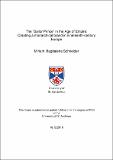Files in this item
The "sailor prince" in the age of empire : creating a monarchical brand in nineteenth-century Europe
Item metadata
| dc.contributor.advisor | Müller, Frank Lorenz | |
| dc.contributor.author | Schneider, Miriam Magdalena | |
| dc.coverage.spatial | vi, 224 p. | en_US |
| dc.date.accessioned | 2018-12-04T16:35:36Z | |
| dc.date.available | 2018-12-04T16:35:36Z | |
| dc.date.issued | 2017-06-22 | |
| dc.identifier.uri | https://hdl.handle.net/10023/16627 | |
| dc.description.abstract | This study examines the systemic function and public role of “Sailor Princes” within the context of the nineteenth-century revival of monarchy. It explores how, between 1850 and 1914, the reigning families of Britain, Denmark, Germany and Greece chose to educate their younger sons in the navy and thereby created powerful links with a mythically invested symbol of national identity and modernity, of bourgeois virtue, imperial integration and exotic adventure. All four countries perceived themselves as maritime powers defined by their long seafaring traditions and/or great hopes for a naval future, by their possession of (in)formal seaborne colonial empires and/or by their substantial imperial ambitions. By latching onto the prominent trend of the nineteenth-century lure of the sea and of naval enthusiasm, the dynasties of Saxe-Coburg, Glücksborg and Hohenzollern were able to adapt these mental geographies for their own purposes and thus to generate an appealing brand image for the emerging political mass market. Prince Alfred of Britain (1844-1900), Prince Heinrich of Prussia (1862-1929), Prince Valdemar of Denmark (1858-1939) and Prince Georgios of Greece (1869-1957) all became powerful personality brands of their respective monarchies. This study investigates the mechanisms and the agents responsible for their success. It examines the role of the sea and of maritime imageries in nineteenth-century national identities; the myths and realities of naval education and naval professionalism; the processes by which seaborne colonial empires and diaspora communities were integrated into larger imperial units and represented to each other via interimperial diplomacy; as well as the public reception, appropriation and recreation of the “Sailor Prince” brand in various popular media, e.g. family magazines, adventure fiction and consumer goods. | en_US |
| dc.description.sponsorship | "I would like to express my gratitude for having received a Douglas and Gordon Bonnyman Scholarship in the Arts for three years from 2012 to 2015." -- Acknowledgements | en |
| dc.language.iso | en | en_US |
| dc.publisher | University of St Andrews | |
| dc.subject.lcc | D352.1S6 | |
| dc.subject.lcsh | Monarchy--Europe--History--19th century | e |
| dc.subject.lcsh | Princes--Europe--History--19th century | en |
| dc.subject.lcsh | Princes--Europe--Biography | en |
| dc.title | The "sailor prince" in the age of empire : creating a monarchical brand in nineteenth-century Europe | en_US |
| dc.type | Thesis | en_US |
| dc.contributor.sponsor | Linda and Gordon Bonnyman Charitable Trust | en_US |
| dc.type.qualificationlevel | Doctoral | en_US |
| dc.type.qualificationname | PhD Doctor of Philosophy | en_US |
| dc.publisher.institution | The University of St Andrews | en_US |
This item appears in the following Collection(s)
Items in the St Andrews Research Repository are protected by copyright, with all rights reserved, unless otherwise indicated.

